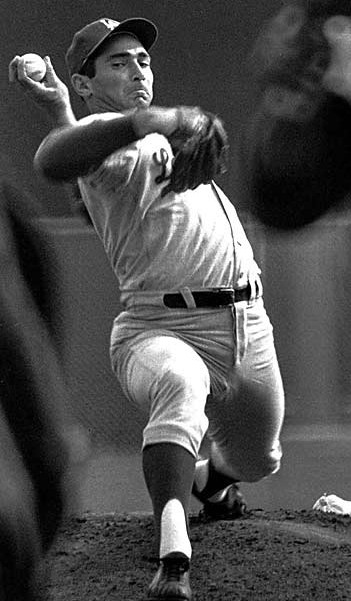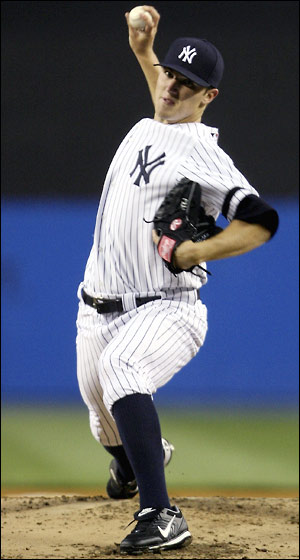On the heels of yet another loss to the hated Red Sox, and entering a crucial series with the hated Mets, the New York Yankees have some 'splainin to do. Namely, they have a pretty tall order explaining the continued presence of one Chien Ming Wang in their starting rotation, given that he seems, statistically, at least, to be no closer to returning to the form that twice amassed 19 wins for them.
Those storied* times, the salad days of 2006 and 2007, seemed much farther than two years away as I watched Wang unravel yet again on Wednesday night against the Red Sox, allowing four runs, including six hits and three walks in less than three innings of work. Believe it or not, that start actually constituted an improvement for him, lowering his ERA ever so slightly from 14.46 to 14.34. Oh goody.
*Not steroid.
Much of the talk about Wang has centered around his heavy sinking fastball, and the idea that he somehow needs to either get his velocity back or his mechanics straightened out so this pitch can again be the grounder-inducing menace that so frustrated the American League in 2006 and 2007. The trouble with this, however, is that he's got all his velocity back, averaging 91-92 mph and often hitting 95 mph on the radar gun with his 4-seam fastball.
The problem isn't his fastball. It's the lack of anything else.
According to FanGraphs.com, between 2005 and 2008, Wang threw his fastballs (including the 4-seam and the sinker) 76.5% of the time, with a velocity averaging between 91.8 and 93.1 mph. This year, while his velocity is just as good (91.7 mph average), he's throwing one or the other of his fastballs 84.7% of the time, a significant difference from his usual modus operandi.
Moreover, most of the extra fastballs are coming at the expense of his slider. Previously he threw the slider about 15% of the time on average, ranging from 12.9% in 2005 to 17.1% last season. This year he's used it only 11% of the time, meaning that there are about half a dozen pitches or more per start that used to be sliders but are now fastballs. And of course, Wang has been getting tattooed all year, so we have to wonder if this is somehow related, right?
This in itself may not be significant, but it got me to wondering why Wang (or his catchers) would be so reluctant to use the slider this season, when he seemed to use it more often and with greater success in the past. Looking at the MLB Gameday data for his last two starts and comparing them to a good start from last year gave me a possible answer:
The slider isn't, well, sliding.
Last year, Wang pitched a complete game, 1-run 2-hitter against the Red Sox in April, no small accomplishment given that those Red Sox finished second in the AL in Runs Scored in 2008 and eventually won the Wild Card. During that game he threw 93 pitches, and according to MLB Gameday, 20 of them were sliders. In addition to the speed of each pitch at release, Gameday provides two measures of the pitch movement, "Break" and "Pitch F/X".
According to MLB.com, Break is
"a measurement of the greatest distance between the trajectory of the pitch at any point between the release point and the front of home plate, and the straight line path from the release point and the front of home plate."That is, I think, the Break is a measure of the difference between where the ball actually ends up and where the batter might think it would end up if gravity and/or spin were not factors.
By contrast, Pitch F/X "is the measurement of the distance between the location of the actual pitch thrown over the plate, and the calculated location of a ball thrown by the pitcher in the same way, with no spin..."
That leaves the method of that calculation as an open question, of course, but assuming that these guys have some idea what they're doing, this seems the more relevant number for our purposes. The batter will assume that the pitch is going to "break" down, if only due to gravity. Even Daniel Bard's fastball, clocked between 98 and 100 mph on Tuesday night, showed a "Break" of three to five inches.
For the record, Wang's fastball/sinker seems largely unchanged, showing a Break of 5-8" and a Pitch F/X of 10-14 " in that complete game against the Red Sox last April. This year, in his most recent start, the fastball was just as fast, showed a typical Break of 5-8" and a typical PFX of 10-13 inches.
But Wang's slider? Last year its PFX averaged 4.05" (with a range of 2-7), but in his two most recent starts, it's averaged just 2.3 inches, almost half of what it once was, and often only zero or one inch. No wonder Posada doesn't want to call for the slider. It isn't fooling anyone because it doesn't do anything, having almost the same trajectory as a pitch thrown without any spin at all, according to MLB Gameday and Pitch F/X. For batters, this is a win-win situation. Either they swing at the occasional slider, which has hardly any spin on it, or they wait on the fastball, which is Wang's only other quality pitch.
The slider is a subtle pitch, so much so that Pitch F/X often has trouble distinguishing it from a cut-fastball and/or even a changeup. It's thrown with a sideways spin that causes it to drift laterally, across the strikzone, in the opposite direction of the pitcher's throwing arm. Because it gets no assist from gravity, the slider doesn't break as much as a curveball does, but it does ehough that it ends up several inches from where you'd expect, either out on the end of the bat or in on your hands, depending on what kind of hitter you are.
The best sliders in baseball (Carlos Marmol, Jonathan Papelbon, Francisco Rodriguez, Chad Billingsley) usually break only 5 to 8 inches or so, but there are plenty of pitchers whose sliders sit in the 4-inch range. But two inches (and often one or none) simply isn't enough to fool major league hitters, who are so well trained that they make mid-swing adjustments in hundredths of a second, and so strong that they can hit a ball out of the park while breaking the bat.
Whether this is a physical problem for Wang or not, I don't know, but I doubt it. Perhaps his foot still hurts, and he's somehow favoring it, throwing the slider less often because it bothers him physically. This is unlikely, as any difference in his delivery due to throwing the slider would be tantamount to "tipping" his pitches, and batters would have picked up on it long ago.
Perhaps he's still rusty, having missed some time due to the foot injury, and doesn't yet have the "feel" for the slider. This seems very likely to me, as pitchers often talk about how difficult it is to get a feel for their sinker, slider or cutter, and how much practice this takes. Having missed more than half of last year, and having thrown only about 21 innings so far this year in the majors (plus 13 scoreless innings in AAA) Wang's a little behind on his usual regimen.
Maybe this means that with a bit more practice, he'll get that feel for the slider - and with it, his confidence in the pitch - very soon, enabling him to keep hitters a bit more honest and not so frequently serve them the heater they already expect. I just wish the "practice" didn't have to come in Yankee Stadium, and against the damn Mets.
Admittedly, I have not looked over all the available data. Wang has thrown hundreds of pitches this year and thousands in his career, and I simply don't have the time to examine every one, but this hopefully gives us an idea of where to look for answers the next time Wang takes the mound.
UPDATE: My apologies for the false information, but it turns out that Wnag's next start is scheduled for Wednesday, against the Nationals, not Sunday. That was Burnett's regular spot, and he pitched well for once. Wang should have been scheduled for Today, Monday, which is an off day and (it would seem) a perfect opportunity to skip Wang in the rotation.
Instead, for some reason Joe Girardi has chosen to start him on six days' rest and push the rest of the rotation (other than Sabathia) back a day against the Washington Nationals. Maybe Joe agrees with my assessment that Wng just needs more work, and figures that if there's any team he can beat, it's the Nats (16-45).
























